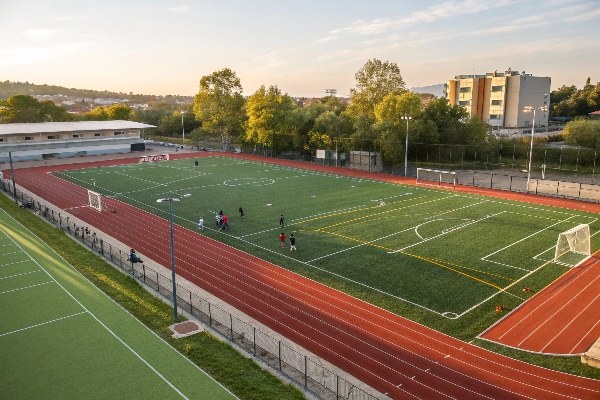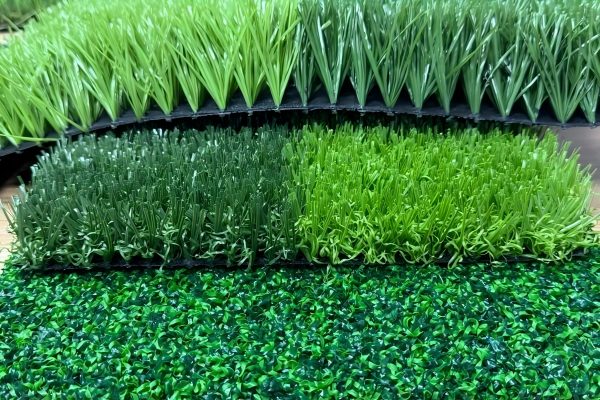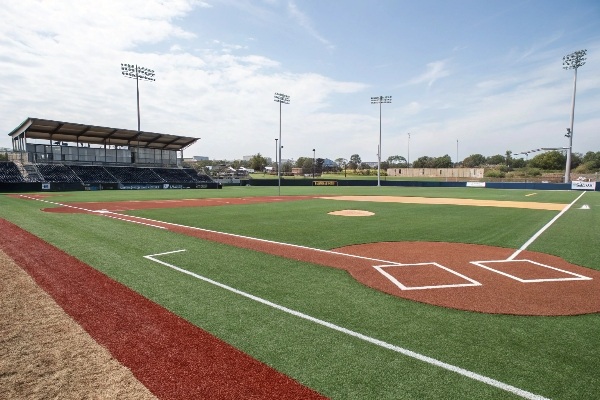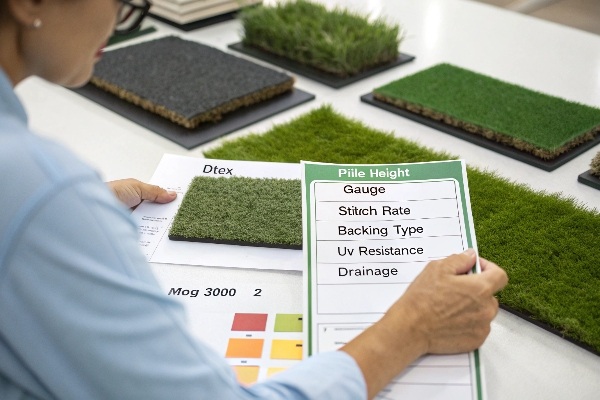Are you worried about your young athletes playing on worn-out, unsafe fields? A bad surface causes injuries. I will show you how to choose the right, safe turf.
For youth sports, the best turf is a system using slit-film polyethylene fibers with a shock-absorbing pad. This setup offers great durability for constant use and superior safety. It helps protect young players from injuries when they fall, making it a reliable and smart choice.

Choosing the right turf is about much more than just the color or price. It is a critical decision that impacts player safety, game performance, and the long-term value of your investment, especially when children are the primary users. The wrong choice can lead to problems, but the right one creates a perfect space for sports to flourish. Let’s look closer at the details you must know to make an informed decision for your sports field. We will break down what makes a turf system great for different applications.
What is the best type of turf for sports?
You need a turf that performs perfectly for every game. But different sports have different needs, which can be confusing. I will explain the key types and their uses.
The "best" turf really depends on the sport. For fast-running sports like soccer, soft polyethylene fiber is ideal for player safety. For high-traffic areas, durable slit-film is better. For a natural look and feel, monofilament is the top choice. Choosing correctly is key.

When I first started in the factory’s technical department, I spent countless hours testing different turf components. I quickly learned that the "best" turf is not a single product, but a complete system. This system has three main parts: the turf fibers (the grass blades), the infill (the material between the fibers), and the backing that holds it all together. For sports, a shock pad underneath is often a fourth, crucial part.
Key Turf Components
The fiber type is what players see and feel. Polyethylene (PE) is the most popular choice for sports like soccer and football. It’s soft, which reduces scrapes and cuts when players fall. Nylon is another option. It’s extremely strong but can be rough on the skin, so we often use it for putting greens or mix it with PE fibers to help them stand up better.
The Importance of Infill
Infill is just as important as the fibers. It provides cushioning, helps the fibers stand upright, and gives the field proper athletic performance.
| Infill Type | Pros | Cons | Best For |
|---|---|---|---|
| Crumb Rubber1 | Excellent shock absorption, low cost | Can get hot in the sun, some environmental concerns | Football, Soccer, General Sports |
| Coated Sand2 | Stays cooler, less messy than rubber | Higher cost, can feel firmer | Multi-sport, Premium Fields |
| Organic (Cork/Coconut)3 | Natural, very cool temperature, eco-friendly | Higher maintenance, may float in heavy rain | Eco-conscious projects, Premium Fields |
The right combination is everything. For a high-use community football field, I often recommend a durable slit-film PE fiber with crumb rubber infill. It’s a workhorse system that provides great performance and value.
What type of turf is used on baseball fields?
A baseball field has very unique needs. The wrong turf can cause bad ball bounces and frustrate players. I will show you what professionals use for a consistent playing surface.
Baseball fields use a mix of turf types. For the infield and baselines, they use a short-pile turf for a true and fast ball roll. In the outfield, a longer, softer pile turf is used to give players more cushion when they dive for a catch.

Designing a turf system for baseball is a fun challenge. You have to think about different zones. The ball needs to act one way on the infield and another way when it lands in the outfield. Plus, player safety is different in each area. You can’t just use one type of turf for the whole field.
Infield vs. Outfield Systems
For the infield, you need a surface where the baseball rolls true and fast. We achieve this with a turf that has a short pile height, usually around 1.25 inches (30-35mm). The fibers are very dense. We also use a lot of sand in the infill mix. The sand weighs down the fibers and creates a firm, stable surface. I remember running tests to find the perfect density for an infield. A high-density slit-film fiber worked best because it resists wear and keeps the ball from taking bad hops.
The outfield is all about player safety. Outfielders run full speed and often dive. Here, a longer pile height of about 2 inches (50mm) is much better. We use more rubber in the infill for extra shock absorption. Soft polyethylene monofilament fibers are perfect for the outfield because they are gentle on the skin during slides and dives.
High-Wear Areas
The batter’s box and pitcher’s mound get the most abuse. For these spots, we use extremely durable turf. Sometimes it’s a very dense nylon fiber that can handle the constant twisting of cleats. I once helped a client in a very dry area install a turf pitcher’s mound. It looked great and saved them so much time and water compared to maintaining a natural clay mound.
What are the different types of football turf?
You want a football field that lasts and keeps players safe. But the options can feel overwhelming and technical. I will simplify the choices so you can pick with confidence.
Football turf fields mainly use slit-film or monofilament polyethylene fibers. Slit-film is known for its incredible durability, holding infill in place under heavy use. Monofilament offers a softer, more grass-like feel that players often prefer. Some systems blend both.

When I was managing a sales team, customers always asked me, "What’s the difference between slit-film and monofilament?" It’s a great question. Both are excellent for football, but they serve slightly different purposes. Understanding this difference helps you choose the best long-term investment for your field.
Slit-Film: The Workhorse
Imagine a wide sheet of plastic that is precisely cut into thin strips, or "slits." That’s a slit-film fiber. When the field is used, these fibers split and fray a little, creating a connected mesh. This mesh does a fantastic job of trapping the infill and keeping it from moving around. This means the surface stays consistent and requires less grooming. Because of this durability, I recommend slit-film for fields that see non-stop action, like community parks or busy high schools. It’s tough and cost-effective.
Monofilament: The Player’s Choice
Monofilament fibers are created individually, like strands of spaghetti. They are designed to stand up straight and look just like natural grass blades. Players love monofilament turf. It’s softer to the touch and reduces the risk of skin burns during tackles. From my experience helping clients, the fields that get the most positive feedback from athletes are often monofilament. The one thing to remember is that these fields may need a bit more brushing to keep the fibers standing tall and the infill evenly distributed.
Hybrid Systems: Best of Both Worlds?
For top-level performance, there are hybrid systems. These combine the durability of slit-film with the soft feel of monofilament in the same stitch. It’s a premium product, but it gives you everything: incredible resilience, a great look, and excellent player comfort. I have seen these systems installed in professional training facilities where performance and quality are the top priorities.
Which type of turf is best?
Every company will tell you their turf is the "best." This makes it feel impossible to know who to trust. I’ll give you a simple framework to decide what is truly best for you.
The "best" turf is the one that perfectly fits your specific needs; a single "best" type doesn’t exist. You must consider the sport, how often it will be used, your budget, and maintenance. A truly great system balances player safety, durability, and cost for your project.

Over my years in this industry, I’ve learned that the most successful projects happen when the customer understands their own needs first. Don’t start by asking for the most expensive product. Start by defining your goals. I always walk my clients through a simple decision-making process based on their priorities. Are you building a field for a professional team or for a local elementary school? The answer changes everything.
A Simple Decision Matrix
Let’s make this easy. Think about what is most important for your project. Is it withstanding heavy use, or providing the absolute softest surface for players? Your main priority will guide you to the right system.
| Main Priority | If your main concern is… | Then you should look for… |
|---|---|---|
| Extreme Durability | A community field used constantly | Slit-film PE fiber, a high face weight (>40 oz), and crumb rubber infill. It is a tough, reliable system. |
| Player Safety/Comfort | A youth sports or premier soccer field | Monofilament PE fiber, a longer pile height (>2 inches), and a shock pad underneath. This provides maximum cushion. |
| Natural Appearance | A high-profile school or stadium | Hybrid or high-end monofilament systems with a thatch layer and organic infill. It looks and plays just like perfect grass. |
| Tight Budget | A practice area or small project | Standard slit-film PE turf. Focus on good specifications like a high stitch rate and a strong backing. Quality is possible at a good price. |
I once had a customer who wanted to buy our most expensive monofilament turf for a small batting cage. I explained that a shorter, more durable slit-film turf would perform better and save him money. He was grateful for the honest advice. The "best" turf is not a product; it is the right solution for your specific problem.
Conclusion
Choosing the right turf means matching the fiber, infill, and backing to your unique sport and usage. Focus on a balanced system for the best safety, durability, and performance.
_画板-1.png)
_画板-1.png)